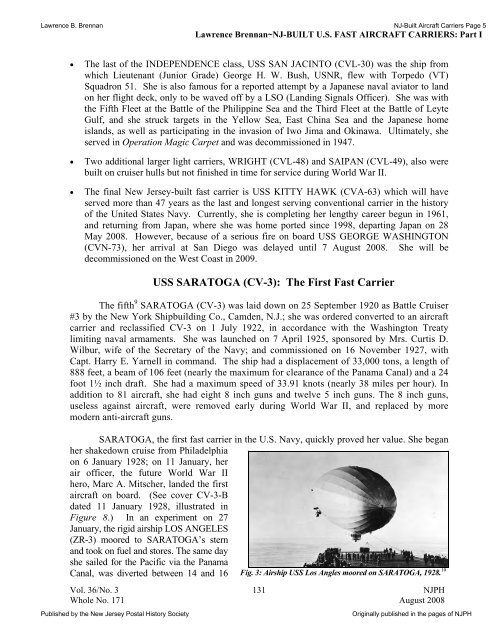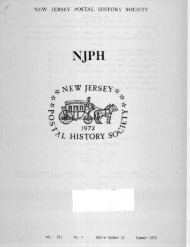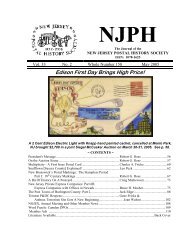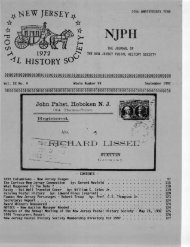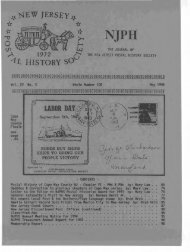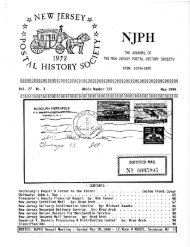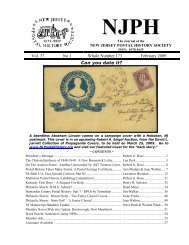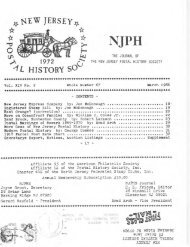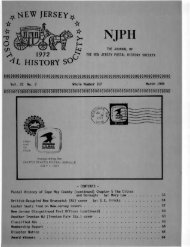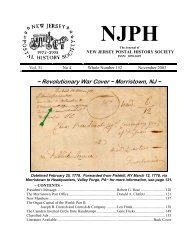By Captain Lawrence B. Brennan, U.S. Navy (Ret.) - New Jersey ...
By Captain Lawrence B. Brennan, U.S. Navy (Ret.) - New Jersey ...
By Captain Lawrence B. Brennan, U.S. Navy (Ret.) - New Jersey ...
You also want an ePaper? Increase the reach of your titles
YUMPU automatically turns print PDFs into web optimized ePapers that Google loves.
<strong>Lawrence</strong> B. <strong>Brennan</strong> NJ-Built Aircraft Carriers Page 5<br />
<strong>Lawrence</strong> <strong>Brennan</strong>~NJ-BUILT U.S. FAST AIRCRAFT CARRIERS: Part I<br />
• The last of the INDEPENDENCE class, USS SAN JACINTO (CVL-30) was the ship from<br />
which Lieutenant (Junior Grade) George H. W. Bush, USNR, flew with Torpedo (VT)<br />
Squadron 51. She is also famous for a reported attempt by a Japanese naval aviator to land<br />
on her flight deck, only to be waved off by a LSO (Landing Signals Officer). She was with<br />
the Fifth Fleet at the Battle of the Philippine Sea and the Third Fleet at the Battle of Leyte<br />
Gulf, and she struck targets in the Yellow Sea, East China Sea and the Japanese home<br />
islands, as well as participating in the invasion of Iwo Jima and Okinawa. Ultimately, she<br />
served in Operation Magic Carpet and was decommissioned in 1947.<br />
• Two additional larger light carriers, WRIGHT (CVL-48) and SAIPAN (CVL-49), also were<br />
built on cruiser hulls but not finished in time for service during World War II.<br />
• The final <strong>New</strong> <strong>Jersey</strong>-built fast carrier is USS KITTY HAWK (CVA-63) which will have<br />
served more than 47 years as the last and longest serving conventional carrier in the history<br />
of the United States <strong>Navy</strong>. Currently, she is completing her lengthy career begun in 1961,<br />
and returning from Japan, where she was home ported since 1998, departing Japan on 28<br />
May 2008. However, because of a serious fire on board USS GEORGE WASHINGTON<br />
(CVN-73), her arrival at San Diego was delayed until 7 August 2008. She will be<br />
decommissioned on the West Coast in 2009.<br />
USS SARATOGA (CV-3): The First Fast Carrier<br />
The fifth 9 SARATOGA (CV-3) was laid down on 25 September 1920 as Battle Cruiser<br />
#3 by the <strong>New</strong> York Shipbuilding Co., Camden, N.J.; she was ordered converted to an aircraft<br />
carrier and reclassified CV-3 on 1 July 1922, in accordance with the Washington Treaty<br />
limiting naval armaments. She was launched on 7 April 1925, sponsored by Mrs. Curtis D.<br />
Wilbur, wife of the Secretary of the <strong>Navy</strong>; and commissioned on 16 November 1927, with<br />
Capt. Harry E. Yarnell in command. The ship had a displacement of 33,000 tons, a length of<br />
888 feet, a beam of 106 feet (nearly the maximum for clearance of the Panama Canal) and a 24<br />
foot 1½ inch draft. She had a maximum speed of 33.91 knots (nearly 38 miles per hour). In<br />
addition to 81 aircraft, she had eight 8 inch guns and twelve 5 inch guns. The 8 inch guns,<br />
useless against aircraft, were removed early during World War II, and replaced by more<br />
modern anti-aircraft guns.<br />
SARATOGA, the first fast carrier in the U.S. <strong>Navy</strong>, quickly proved her value. She began<br />
her shakedown cruise from Philadelphia<br />
on 6 January 1928; on 11 January, her<br />
air officer, the future World War II<br />
hero, Marc A. Mitscher, landed the first<br />
aircraft on board. (See cover CV-3-B<br />
dated 11 January 1928, illustrated in<br />
Figure 8.) In an experiment on 27<br />
January, the rigid airship LOS ANGELES<br />
(ZR-3) moored to SARATOGA’s stern<br />
and took on fuel and stores. The same day<br />
she sailed for the Pacific via the Panama<br />
Canal, was diverted between 14 and 16 Fig. 3: Airship USS Los Angles moored on SARATOGA, 1928. 10<br />
Vol. 36/No. 3<br />
131<br />
NJPH<br />
Whole No. 171 August 2008<br />
Published by the <strong>New</strong> <strong>Jersey</strong> Postal History Society<br />
Originally published in the pages of NJPH


